Lecture
Types of evolutionThere are two possible evolutionary means. Synthesis is a complication by combining simpler organisms into more complex ones. In the whole organism, the number of useful properties grows, the organism's vitality grows. Synthesis is a complication by combining simpler organisms into more complex ones. In the whole organism, the number of useful properties grows, the organism's vitality grows.  Segregationogenesis is the differentiation of a function into separate subsystems. There is a rejection of universality (analogue of specialization). Segregationogenesis is the differentiation of a function into separate subsystems. There is a rejection of universality (analogue of specialization). The quality of the function increases and the time spent decreases. |
Three possible paths of development Orogenesis - expansion of adaptive possibilities, i.e. increase in the number of ecological niches of the body. Orogenesis - expansion of adaptive possibilities, i.e. increase in the number of ecological niches of the body.  Allogenesis - change of several functions to new ones, while the old ones are discarded. Allogenesis - change of several functions to new ones, while the old ones are discarded.  Telogenesis is a very deep specialization and adaptation (full penetration into the environment). Telogenesis is a very deep specialization and adaptation (full penetration into the environment). |
The overall goal is to improve adaptation to the environment. |
Von Neumann structureU is a universal constructor; D - copying machine; C - control machine that reads descriptions and executes instructions. {U, D, C} - M-machine, capable of reproduction. |
Von Neumann's structure of reproduction. |
 Fig.9.1 |
Initially, there should be one machine, and in the environment there should be all the necessary elements for building a new machine. |
Nanotechnology10 -9 meters - nano-atomic level. |
Molecular nanotechnology is engaged in the design, modeling, production of molecular machines and devices. Ancestor - Eric Drexler (1992). |
Tunnel microscopeInvented by IBM. With the advent of the tunnel microscope, the development of nanotechnology became possible. With it, you can see the atomic structure of various objects. Atoms can be towed - it is advisable to change the location of atoms. |
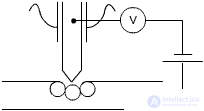 Fig.9.2 |
In order for nanotechnology to become profitable to build structures capable of reproducing themselves (molecular assembler). |
The product is made as follows: |
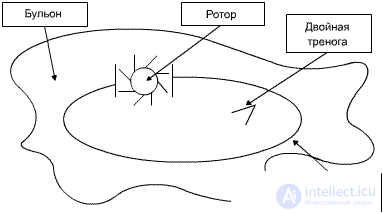 Fig.9.3 |
The rotor catches the desired atoms from the broth. Inside the capsule is an inert compressed gas and a double tripod. A double tripod catches the elements and builds the product. The tripods have ratchets, which are actuated by overpressure of the gas in the capsule. Control information is transmitted using acoustic waves. Diamantoid (high strength, lightness, chemical inertness, heat resistance) and fullerene (symmetry) act as a building material. |
Since the widespread introduction of nanotechnology, humanity will plunge into a new environment. All spheres of vital activity will change. More details in the articles: |
ImmortalityOne of the products of nanotechnology can be immortality. Aging comes when the cells cannot "faithfully" perform the functions imposed on them. But if you periodically replace the cells, the process can be stopped. But this requires copying a person with an accuracy of an atom and allowing nanomachines to rebuild the organism (to return it all the time to the original memorized state). But here the following problem arises: At the same time it is impossible to remove information about the state of all atoms. This is contrary to the principle of uncertainty Heisenberg. Only by stopping all the processes, you can achieve this, but then you need to give the body an absolute zero temperature that is not achievable. |
It is important to answer the following question. If you copy the state of all the cells of the body to a hard drive, for example, then you can build a virtual person using this description and then interpret it in a computer environment. Probably, it is even more economical than returning it to the overpopulated real world. In virtual reality, it will develop, there it can interact with other objects, space. There in the network space can meet with other individuals. |
More details in the articles: |
M. Soloviev "Nanotechnology - the key to immortality and freedom"Currently, three areas are considered the most promising for extending a person’s life: anti-aging, cryonics, and uploading. To achieve the most significant results in them, to make a revolutionary breakthrough in solving the problem of personal immortality is possible using nanotechnology (NT). Immortality, along with other achievements of NT, will fundamentally change the social structure of society. |
Molecular Surgery and Molecular Robots In the most general formulation, the problem of applying NT in medicine is the need to change the structure of the cell at the molecular level, that is, to carry out "molecular surgery." These can be such operations as recognizing certain fragments of molecules and cells, breaking or joining parts of molecules, adding or removing molecular fragments, completely disassembling and assembling molecules and cellular structures according to a specific program. Although they are carried out by ordinary, natural protein molecules, the set of functions of the latter is insufficient to ensure the immortality of the cell and the whole organism. The task, therefore, is to give the cell these missing functions, to "manage" its work. |
Molecular surgery devices are commonly referred to as molecular robots (MR). They are analogous to a more general NT device, called an assembler / disassembler1. MR can be created on the basis of biological macromolecules (mainly proteins). This approach is called molecular nanotechnology. The main problem of its implementation is the design of the MR. The main element of such a design is molecular modeling. Although his algorithms are known, the large size of the molecules makes the calculations very laborious. Now such calculations are possible only for the analysis of small modifications in existing molecules. According to forecasts, computers will reach the power required for acceptable speed (and price) for modeling molecules by 2010 — that is, molecular NT can be implemented in 15–20 years. Given the need to develop specific types of MR and conduct additional biological research, it can be expected that the features described below will be available in the second quarter of the 21st century. (You can use the services of cryonics to wait for this time now). |
For medical applications, hybrid MR manufacturing technology may also be promising. For example, detectors and manipulators are made from organic molecules, and the control device can be solid-state, silicon-based. In addition to the possibility of detection and manipulation of biomolecules, an important problem is the energy supply of the MR and their interaction with the supercomputer manager. Here, it seems promising to use a magnetic field, since biological tissues are transparent to it. The magnetic field can change the structure of the MR, charging it with energy and communicating information, and to communicate information to the control computer, the MR can change its structure itself, which will be registered by sensors located outside the human body. An analogue of this approach is nuclear magnetic resonance imaging - a method that is now widely used to obtain three-dimensional images of internal organs in real time. Another approach to creating molecular robots is to fabricate them from crystalline materials based on carbon, silicon, or metals. Its implementation is associated with the progress in the miniaturization of existing solid-state technologies (etching, spraying, growing crystals). The principles of their work will consist in mechanical action on cellular structures or in the creation of local electromagnetic fields for the detection and initiation of chemical changes in biological molecules. Forecasts here are more difficult to do, since the key technological processes necessary to achieve nano-dimensions are still in the early stages of development. |
Anti-aging The primary cause of aging is damage to cell molecules — thermal, radiation, and by-products of biochemical reactions. In the process of evolution, various anti-aging mechanisms (natural anti-aging) have been developed, which act at both molecular and higher levels — cellular, tissue, and organism — levels. However, these mechanisms are not 100% effective, and the gradual accumulation of molecular damage leads to deterioration of cell functioning, cell death, which causes a catastrophic dysregulation of body functions, the appearance of systemic "aging diseases" (most forms of cancer, atherosclerosis, hypertension, diabetes mellitus), weakening resistance to harmful effects; all this inevitably leads to death. 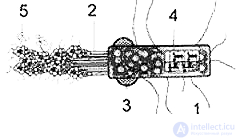 Fig.1 Hybrid Molecular Robot. 1 - Fibers for moving and fastening; 2 - control fibers; 3 - the stock of atoms; 4 - built-in computer; 5 - manipulation endings. From the book Cryonics: Reaching for Tomorrow, with permission from Alcor Life, Extension Foundation, USA. |
The lack of effectiveness of natural anti-aging is due to the fact that evolution operates by trial and error, that is, the necessary adaptation does not appear immediately and in a complete, perfect form. In principle, one can imagine that a practically non-aging organism could appear. But the evolutionary “search” of long-lived organisms and the consolidation of its results are possible only if such an organism has evolutionary advantages, manifested in high survival rates and an increase in the number of the species (otherwise, the “found” trait will be lost ”in the next generations). However, for the well-being of the species it is quite enough that a separate organism could reach reproductive age and leave offspring, and what will happen with the organism further does not matter for the species (or has a negligible value). In other words, the way to increase reproductive and vitality at a young age (which, as a rule, adversely affects health at older ages) is simpler and more beneficial for the species (and therefore more likely) than an increase in the life expectancy of an individual (for this random search and, apparently, a coordinated change in a large number of functions, the probability of which is very small). |
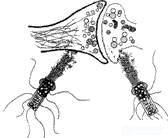 Fig.2 Molecular robots examine and restore synapses 1 . From the book Cryonics: Reaching for Tomorrow, with permission from Alcor Life, Extension Foundation, USA. |
So, today we have an aging organism, but which in principle can be changed, if we act not by trial and error, but purposefully, systematically correcting its functions at the molecular and organism levels. What can the MR do here? First of all, they can repair (“repair”) a cell — correct damage to its structure that, for one reason or another, has not been repaired by the cell's natural repair systems: cut molecular cross-links in lipid membranes and proteins (which causes deterioration of their functioning), remove accumulating harmful metabolic products (such as lipofuscin granules in the nerve cells), correct the damage in the genetic material of the cell (where even a single violation in a critical place can lead to the occurrence of cancer). MR, introduced (just like viruses do) into a cell and performing similar operations, will ultimately lead to rejuvenation of the body. Moreover, MPs can increase the degree of cell protection - preventing the occurrence of molecular damage, which will mean cell non-aging. For example, they can inactivate free radicals escaping from natural defense systems (containing an unpaired electron, highly reactive and non-specifically active molecules), which are a by-product of many biochemical reactions and are one of the main causes of molecular damage. Also, MRs can participate (both along with genetic engineering and instead of it) in redesigning the cell genome — in altering genes or adding new ones to improve cell functions. It is quite possible that in the long run, after such an improvement, to ensure the "eternal youth", the MRs will no longer be needed (or they will be produced by the cell itself). |
Cryonics |
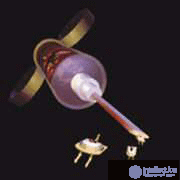 fig.3 Injection of suspension of anti-cancer microrobots. |
Although cryonics has been used in America since the late 1960s, it has not yet become a generally accepted procedure (about a hundred people have been frozen to date). There are several reasons for this. One of them is the financial collapse of the leading cryonics organizations in the late 1970s, which led to patient defrosting and, as a result, a lack of confidence in storage (now the funding strategy has been replaced by a more reliable one). The other is a deeply rooted belief in public consciousness that death is inevitable (usually this attitude is expressed in abundant religious and sociological arguments about the "usefulness" of death, the psychological desire to "be like everyone else" —that is, as dead). The third is that many people do not really want to live long, although they declare it, but when they are required to make any serious efforts to prolong life (and pay big enough money - from 30 thousand dollars), most of they prefer to die in peace. The fourth is that there are only theoretical substantiations of the working capacity of cryonics. This is enough to convince people with the necessary scientific background and strong motives to spend efforts to analyze these rationales, but there are very few such people. To convince the majority, we need experimental results that can be obtained after the realization of the capabilities of NT. (It is worth noting that leading American experts in the field of NT are supporters of cryonics, and some of them have a contract for freezing). |
In cryonics there are two main problems that can be solved with the help of NT. The first is that, according to the existing laws, patients can be frozen only after receiving a death certificate, that is, when doctors are convinced that modern resuscitation technology can no longer save them (this does not mean that future medical technology, enhanced by MR, will not able to do it). Usually it takes from several tens of minutes to several hours. During this time, the body receives quite serious damage at the cellular level due to the cessation of oxygen supply. However, theoretical assessments and a number of experimental data suggest that the brain structures that provide long-term memory (and therefore the integrity of human consciousness and personality, his memory of the past) do not have time to collapse during this time. This means that from the point of view of the theory of information (and in the medicine of the future only this will be the real criterion of death) a person is still alive. |
Another problem is that modern freezing technologies make it possible to carry out a full cycle of freezing / thawing only for biological objects of small size (several millimeters). In larger objects, both due to uneven saturation with antifreeze (without this, safe freezing is impossible at all), and due to the resulting temperature gradients, numerous damages occur on the cell (cell wall gap) and on the tissue (microcrack) levels, which makes simple defrosting, without prior repair of damage, is impossible. These damages, as well as the consequences of partial cell destruction due to oxygen starvation during clinical death, are designed to eliminate MR (according to preliminary calculations, it will take about a billion billion MR, their total weight will be about half a kilogram, and the time of repair-defrosting-resuscitation treatment-rejuvenation will take several months). MR operations will be about the same as in the case of anti-aging. In particular, this will mean that after mediating MR defrosting and resuscitation, the disease that caused the death will be cured (for example, cancer or AIDS — a number of such patients are already frozen); then the revived person will be rejuvenated (the oldest person was frozen at 99); moreover, a person killed in an accident or killed can also be revived (for example, a frozen lawyer, killed by a client dissatisfied with his work, lies frozen). |
Loading |
Implications for society 1 Синапсы -- места межклеточных контактов нейронов головного мозга, основные элементы долговременной памяти человека. |
"Обратите внимание: я не определяю абсолютную ценность творений человеческих рук. По моему убеждению, они исчезнут и появятся в новой форме, о которой мы даже пока и не догадываемся. С другой стороны, эти предметы обладают преходящей ценностью - они есть необходимые стадии процесса, которые мы должны миновать в ходе своего Преображения. Я восхищаюсь не формой, а функцией, которая заключается в том, чтобы неким таинственным образом создавать сначала богоподобное, а затем, по Господней милости, и божественное".
Пьер Тейяр де Шарден, французский богослов, декабрь 1919 г.
Человек - удивительное существо. Его всегда тянет к крайнему, к предельно достижимому. Одни с радостью и восторгом стремятся заглянуть за грань достижимого. Другие, которых эта грань притягивает не меньше, в силу особенностей своего характера находят удовольствие в том, чтобы пугаться самим и пугать других таящимися за ней чудесами:
Это свойство человеческой натуры проявляется вновь и вновь на каждом новом витке развития технологии. Классический пример - стремление людей к полету, к небесам. Человек пытался - реально или в воображении - приспособить для достижения этой цели каждую техническую новинку. Точно так же обстоит дело и со второй извечной мечтой человечества - с желанием ощутить себя творцом живых, а желательно, еще и разумных существ. Новый всплеск интереса к этой теме возник в связи с появлением нанотехнологии. Ее первые, пока довольно скромные, но завораживающие в перспективе успехи, породили и волну мечтаний о возможности создания искусственных живых и даже разумных существ, и мутный поток страхов перед возможной реализацией самых чудовищных кошмаров человечества. Давайте же попытаемся понять, насколько обоснованы мечтания: сколько разумной осторожности и сколько густопсового обскурантизма в страхах тех, кто требует запретить или, как минимум, ограничить развитие нанотехнологии (так же, как перед этим требовали запретить биотехнологию, атомную и простую физику, медицину и естествознание).
Создадим гомункулуса?
Тяга к роли творца, стала присуща роду человеческому начиная с того момента, когда в общественном сознании оформилось представление о Творце, создающем людей. Без этого, из одних лишь наблюдений за природой, за цепочкой рождений и смертей, трудно сделать вывод о том, что живое можно не только родить, но и создать. Не важно, разделяете ли вы или нет библейскую картину создания мира и человека, но наличие в общественном сознании самых разных народов и племен представления о творении жизни оспорить вам будет трудно. Вначале, во времена Аристотеля, все было ясно и понятно. 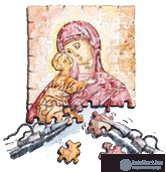
"В разлагающихся телах зарождаются живые существа, потому что обособившаяся теплота, будучи природной, соединяет вместе выделившиеся части". (Аристотель. Метеорологика. Книга 4, список 379, строки 9-12.)
Опыты продолжались столетиями. Да что там столетиями - тысячелетиями. Взгляды Аристотеля на самозарождение жизни разделял еще Линней. А уж он-то был не самым диким среди естествоиспытателей XVIII века!
Взять всяких отбросов, объедков, гнили и прочего, закупорить их в бутыль нужных размеров - и вот, к вашим услугам, гомункулус, искусственный человечек. Авторитет Аристотеля был столь велик, что в его рецептах никто не сомневался...
"Колба с химикатами" versus "elan vital"
Полное и точное описание истории попыток синтеза живой материи выходит далеко за пределы темы данной статьи. Трудно даже приблизительно систематизировать взгляды всех тех, кто размышлял и экспериментировал в этой области. Но грубо (подчеркиваю - грубо ) их можно разделить на две группы.
It is a mechanics. It is reduced to a natural law.
Just as the physicists of the times of Newton and Laplace were convinced that, knowing the position of each atom in the Universe, one can determine its future and its past with any arbitrarily small error, so in biology supporters of this approach to the creation of living matter believed that the movement of molecules fully describes the functioning of living matter. She has no systemic, emergent properties.
Another, directly opposite approach to biology is called vitalism. It consisted in the fact that it recognized the existence of a certain vital force, which was called vis vltalis, elan vital. This life force created living matter from inanimate, but in some mysterious way it was inherent only in the first. According to the vitalists, it was fundamentally impossible to create the living from the nonliving.
Who was right in the dispute between the mechanists and the vitalists? The answer at the present level of development of natural science is clear: no one. This very dispute itself, in exact accordance with the ancient rules of dialectics, derived from the science of disputes and reasoning, moved to the next level.
Wave genome
In the 1940s, when Soviet biological science was entertained by the study of the origin of the eggs of cuckoo eggs from the warbler eggs (the original works of Stalin's academician Lysenko), world science moved to the next level of knowledge of the mystery of life.
What is a photon - a particle or a wave? That and that, quantum mechanics answers.
Is life a mechanical movement of atoms or is it inherent in the spirit of life? The answer may be given: both.
The possibility of such an approach is evident from the analogy invented by one of the creators of quantum mechanics, Schrodinger, who compared life with a crystal.
The properties of a crystal are determined not so much by its chemical composition, as by the structure of the crystal lattice. The bond between atoms is described by quantum mechanics, a paradoxical science in which some questions are meaningless and some measurements are impossible. Schrödinger's work was followed by the discoveries of Scream and Watson, who discovered that heredity — this amazing ability of living matter to replicate, restore its body, and give birth to a new one — is encoded in double-stranded nucleic acids. At the new level, the mechanistic approach began to be revived: let's reproduce the DNA helix - and get a copy of the body. Emerged biotechnology. But it is much closer to selection than to the creation of artificial life.
What prevents to overcome the barrier between the living and nonliving? It seems that the same thing, which does not allow us to calculate the future of the Universe from the positions of all its constituent atoms, is a quantum mechanical barrier. In 1995, a book by P. P. Gareev , The Wave Gene, was published in Moscow. It contained the results of dozens of experiments confirming, in the author's opinion, that the genome, the repository of information about the heredity of a person and any living creature, is of a wave (in the quantum mechanical sense of the word) nature. In other words, the Schrödinger function for the genome (the DNA helix carrying genetic information) is not a superposition of the Schrödinger functions of individual sections of this genome. Heredity, the ability to replicate, to life, is not determined by the simple superposition of the properties of the elements carrying it. There really is a transition to a different quality. Here the vitalists are right ... But there is no elan vital, of course, there is no genome in the function of Schrodinger. There are laws of quantum mechanics that are common to all matter - and here materialists are right. Another thing is that these laws are applicable here to the description of the phenomenon, which has some special, not fully understood patterns.
Dwarfs power limit
I needed such a long historical excursion to answer the question: how can modern nanotechnologies be used to artificially create living tissues, organs and whole organisms? Will they be more effective than the forces acting on the dirt in the flask of the alchemist? So, nanotechnology. Dwarf technology (in ancient Nanos means "dwarf"). The possibility of using a tunneling microscope to pick up a single atom and move it to the right place. Will they be able to create living, genuinely living tissue from these atoms? Reproduce organ? Animal? And a man?
We agree that the restrictions associated with the characteristics of specific technological equipment, the bandwidth of information channels that manage this equipment, as well as the cost of the work, we will not consider. The discussion will deal only with the fundamental possibilities and restrictions imposed by those laws of nature, which are now generally regarded as fundamental. So, what is the main idea of creating living matter based on nanotechnology?
The living tissue is taken as a prototype. It is scanned, that is, it is removed from the information about what atoms and where it is located. Then, on the basis of this information, some nanotechnological device, for example, a tunneling microscope, in the reproduced sample, the same atoms are placed in the corresponding places. If this process proceeds fast enough so that both the original tissue and the recreated duplicate do not deteriorate, then we will get an artificially created living tissue. Organ. Living being. Man ... Is it feasible?
Modern science does not give an answer to this question. If the main characteristics of a living being are contained at the molecular level, then this seems possible. If some part of information about how living matter differs from inanimate matter is hidden somewhere deeper, then there are fundamental difficulties. The scanning process will inevitably rest against the barrier caused by the Heisenberg uncertainty principle. This fundamental rule states that the minimum amount of energy imparted to the system when measuring its state is inversely proportional to the measurement time. That is, we can measure something, such as the coordinates of an elementary particle, quickly, but inaccurately, or we must measure them for a very long time. In the second case, the information on the coordinates of a complex system is likely to simply lose relevance, and the system reproduced on the basis of such information will simply not be adequate and workable, that is, alive.
Where is the information stored on what makes living matter alive? At the molecular or subatomic level? The mentioned book by P. P. Gareev seems to prove the wave properties of the genome, that is, part of the genome information is stored at the level where the laws of quantum mechanics apply. I had to deal with cases where a person with very severe brain damage retains memory and sanity. (Such cases are well known to field neurosurgery. Those interested can look into the book "The Neuroscience of Wartime . " M., 1949.) This suggests that the degree of redundancy of those elements that keep a person’s consciousness is much higher than that if we consider them to be the basic element of the neurons or cells of the neuroglia. It seems that memory sits deeper, on a quantum level. But this is only my judgment ... There are also opposing judgments, much more authoritative ...
Creacianism and traducism
I will allow myself again to be distracted from technological issues and turn to the theological, based on Scripture, accepted by believers for Divine revelation, the position of the Christian church in the matter of human arrangement. It is generally believed that the church speaks of the opposite of soul and body. This is not true. There are three levels in a human being. Physys, the lower body, in Greek, is the physical, or, as they say now, somatic level. The average associated with the vital activity of the body, psychos - this is the soul, the totality of all processes in the body, ending with death. Upper, higher, non-material, in Greek called pneymos - the spirit, pure information, the idea of this particular person. It is the spirit that makes man human. It is the spirit, according to the views of monotheistic religions, that can survive after death. It is interesting that the general Christian doctrine, as if foreseeing the disputes of scientists of the end of the twentieth century, does not give an unambiguous answer how the soul and spirit are transmitted to living organisms. There are two opposite approaches in Christianity. In one of them, in traducism (from the Latin traducio - I convey), it is stated that the creation of life ended on the sixth day of biblical cosmology with the creation of Adam. After that, the soul is only transmitted from parents to children. Proponents of this approach were Tertullian and Luther.
The opposite approach is called creationism (from the Latin creatio - creation and anima - the soul; not to be confused with creationism). According to creatanicism, the soul and spirit are created by the Creator at the birth of man. This view is held by the neotomists. This issue is not included in the Creed, and as far as I know, because of the disagreements connected with it, no one was burned at the stake. But the attitude to abortion, which causes fierce disputes in the most developed countries, is determined by the solution of this dilemma. If you accept the tragic doctrine, abortion is unacceptable from a religious point of view. If, however, one chooses a creationist, then abortion is permissible until the moment of “embedding” in the germ of the soul, and the question arises: when does this “embedding” occur? An unequivocal answer, by the way, the Holy Scripture does not give these questions ...
So can nanotechnology be used to copy these human or animal components?
With the body, it seems the easiest. We fix the original sample in some way and create its exact atomic copy. But will she, this copy, live?
The answer to this question is very closely related to the problem of hibernation, that is, the preservation of organisms alive at low temperatures. The phenomenon of anabiosis is widely known in biology. But here is a man ...
In the United States, firms engaged in freezing the bodies of dead or fatally ill people in liquid nitrogen are functioning successfully (in the sense of profit!). This is done in order to preserve their bodies until the time when medicine learns to cure diseases that have brought the unfortunate to the grave. It is assumed that then they will be unfrozen, removed from the state of clinical death and cured. Those involved in this work believe that the bodies have a good chance of an “artificial resurrection,” because the tissues in liquid nitrogen remain alive.
Successful examples of the "resurrection" yet. Is it possible in principle? And will they be “unfrozen” by full-fledged people or idiots with a blurred mind? The answer depends on where the vital information and consciousness information is stored. If the entropy processes at this level are negligible at liquid nitrogen temperature, resurrection is possible. If not - sorry: However, you can switch to liquid helium. Technologically, however, it is very difficult. But it is worth remembering: in accordance with the third law of thermodynamics (the Nernst principle), entropy becomes zero only when it reaches absolute zero. And this is impossible in principle ... So, it is impossible in principle to keep living tissue completely intact. Damage will always accumulate. The point is - will they be compatible with life or not? You can only learn this in practice ...
Golem Precedent
Most likely, in order to obtain practical results, you will have to use some combination of nanotechnology and computer science methods. To illustrate, let us turn to the medieval legend of the Golem.
According to legend, the Prague Rabbi Leo created an artificial being - Golem (in Hebrew - “lump”, “unformed”, “unprepared”) in order to serve him on Saturdays, when Orthodox Jews are forbidden to work. The golem was made of red clay and animated with the help of a piece of paper with the name of God put in his mouth. Isn't it true, there is a certain analogy with the creation of computer equipment: the hardware is enlivened with the help of information recorded on some kind of carrier, even in my memory - on punched cards. And the continuation of the legend is very important. When Gol rebelled against the creator, Leo finished him off by removing a piece of paper from his mouth. Very similar to the nightmare of pursuing those who buy foreign computers and chipsets for the development of weapons systems. What if the adversary with the help of the notorious “embeddedness” can deprive a computer of a program, and the mighty rocket complex will be scattered into pieces, like a clay statue?
So, most likely, bodies created with the help of nanotechnology or something like that will have to be revived, additionally programming them, passing them additional information that makes them viable. Soul and Spirit will be introduced into an artificial body. This information will be simpler in the case of recreating an artificial organ and much more complex if an artificial animal is created. In the case of a person, the task becomes extremely difficult, because for this you need to understand what is human consciousness and how it functions.
But there is no reason to consider this task as intractable. Perhaps, to obtain information which, due to the uncertainty principle, cannot be directly measured, methods of behavioral modeling will be used, in which the model is formed on the basis of observations of the external behavior of the object. (George Kuznetsov recently wrote about such technologies in the article “Introduction to the specialty.”) It seems to me that another approach is possible - an approach based on methods that have recently been the privilege of the humanities. Here, the crux of the matter lies in the "convolution", the consolidation of vast amounts of information through the realization of something close to our senses.
To illustrate, ask this question: what will tell you more about women, the results of scanning the skin of a hundred thousand women or a dozen Shakespeare's sonnets? So, programming the consciousness on an “ultra-high”, emotional level can be more effective than “frontal” approaches.
"Perverted Animal"
Well, will there be a reasonable artificial creature created with the help of these manipulations, a man?
To do this, you need to understand what a person is, what constitutes his essence. Both atheistic philosophy (Jean-Paul Sartre, Jean-Paul Sartre) and modern theology (Paul Tillich, Paul Tillich) agree on an existential approach to this problem. "The essence of man is existence." Like this! No more and no less! Existence in its entirety and without any deductions. (This, by the way, perfectly corresponds to the fundamentalist approach to the Holy Scripture, which promises people the lot of children of God, Children ... And when, if not in childhood, existence manifests itself in its fullness and freshness!) Well, the futility of trying to reduce the essence of man to what Someone in a simplified formulation is beautifully shown in the novel “People or Animals” by the French writer Vercore (this is the name of the Russian translation, in the original: Vercors “Les animaux denatures” - “Perverted Animals”). In this novel, they try to define man as the only animal that commits sexual perversions, and fail, because such occur even in drakes ... So it is possible to determine the measure of humanity of artificial intelligence only on the basis of complete observations of its relationship with nature and people. And a priori to fear "inhuman monsters in human form" is not worth it. It is unlikely that they will be more bloodthirsty than the cannibals of New Guinea or the henchmen of Beria or Pol Pot.
But to have something large enough in hand to knock out the brains of any Artificial Intelligence without any problems is certain. If you do not believe the Holy Scripture, which says that the history of mankind will end in war, then at least think about the fact that war is a more existential occupation than the search for power, wealth or sexual pleasures ...
Comments
To leave a comment
Artificial Intelligence
Terms: Artificial Intelligence